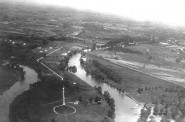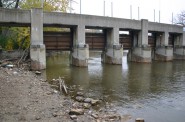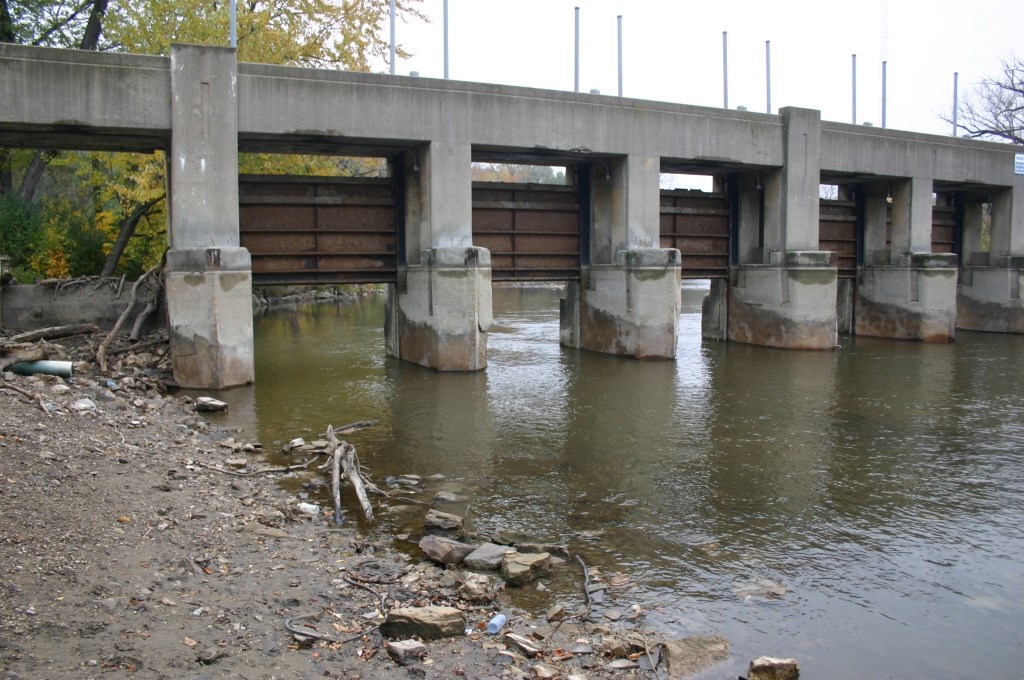Estabrook Dam’s Golden Age for Swimming
It was a huge success, with heavy use of public swimming and beaches. What happened? Part 3 of series.
Estabrook Dam was completed in early 1940 as part of a unique flood control project that would also transform Lincoln Park into a regional amenity focused on recreational activities (boating, swimming, ice skating) making use of the impoundment formed by the dam. As noted in the previous article, shortly after the dam was completed it was subjected to a record-breaking deluge on June 22-23, 1940 with rainfall totals of 5.97 to 7.29 inches reported at local weather stations. The water level at the dam rose only 6-inches during this major flood, according to the Milwaukee Journal, June 24, 1940, and the dam functioned as designed. Based on searches of Milwaukee Journal Sentinel on-line article archives as well as summaries presented in recent technical reports for the dam, there appear to have been few newsworthy incidents for several decades following its construction.
The years immediately following construction of the dam appear to have been a golden age for swimming in the Milwaukee River, with public swimming beaches and facilities in use at Estabrook Park, in Lincoln Park, and in Kletzsch Park. Nearly 173,000 swimmers or beachgoers were reported at the Estabrook Park beach alone in 1941. Unfortunately, increasing pollution problems only a few years later resulted in closure of all three beaches by 1951.
Meanwhile, dramatic shifts were occurring in the demographic characteristics of the neighborhoods surrounding the dam and Lincoln and Estabrook Parks. The most dramatic change was in the number and percentage of African American residents, as summarized on the table below. (All data is from the U.S. Decennial Census, except for 2014, which came from from the U.S. Census American Community Survey.)
| Year | Type of Data | Tract 23 (Milwaukee – directly west of historic Lincoln Park beach) | Tract 22 (Milwaukee – adj. to Silver Spring Dr.) | Tract 44 (Milwaukee – including area north of Dam and west of Estabrook Park) | Tract 602 (Glendale -including Lincoln Park) | Totals |
| 1940 | Total Population | 1,464 | N/A | 3,596 | N/A | 5,060 |
| African American residents (#) | 1 | N/A | 0 | N/A | 1 | |
| African American residents (%) | 0.1% | N/A | 0.0% | N/A | 0.0% | |
| 1960 | Total Population | 6,004 | 2,814 | 3,644 | 5,578 | 18,040 |
| African American residents (#) | 39 | 0 | 17 | 0 | 56 | |
| African American residents (%) | 0.6% | 0.0% | 0.5% | 0.0% | 0.3% | |
| 1980 | Total Population | 4,930 | 2,284 | 3,518 | 6,288 | 17,020 |
| African American residents (#) | 3,159 | 502 | 2,254 | 202 | 6,117 | |
| African American residents (%) | 64.1% | 22.0% | 64.1% | 3.2% | 35.9% | |
| 2000 | Total Population | 4,626 | 1,873 | 3,038 | 5,946 | 15,483 |
| African American residents (#) | 4,173 | 909 | 2,236 | 544 | 7,862 | |
| African American residents (%) | 90.2% | 48.5% | 73.6% | 9.1% | 50.8% | |
| 2014 | Total Population | 4,080 | 1,735 | 3,847 | 6,005 | 15,667 |
| African American residents (#) | 3,752 | 850 | 2,695 | 877 | 8,174 | |
| African American residents (%) | 92.0% | 49.0% | 70.1% | 14.6% | 52.2% |
In 1940, at the time of the dam’s completion, there was one African American resident recorded in the two census tracts for which data are available. By 1960, only 56 African American residents were recorded among the 18,040 residents, or less than 1 percent of the population in the four census tracks in this area. But the black population grew to nearly 36 percent of the residents by 1980 and nearly 51 percent by 2000.
Recent History of the Dam (1987-2015)
The series of events leading to the current legal and political standoff arguably began in 1987 when all ten gates of the dam were reportedly replaced with steel slide gates. This was likely the largest repair, and most significant upgrade to the dam since its completion in 1940. Manual controls on four of the gates were also reportedly replaced with “electric operators” to reduce the difficulty of opening and closing the gates. In 1994, two inspections of the dam were completed by the Wisconsin DNR. This same year marked the completion of the initial phase of Milwaukee’s Deep Tunnel System and completion of a Remedial Action Plan for the Milwaukee Estuary Great Lakes “Area of Concern,” important milestones in efforts to improve the water quality and ecological health of the Milwaukee River.
The dam inspections were in response to the development in the early 1990s of a Wisconsin Dam Safety Program, which included requirements for owners of dams related to maintenance, repairs, modifications, and abandonments. Based on the inspections, WDNR issued a Dam Inspection Report on January 13, 1995, that identified a series of required repairs as well as a schedule for completion of the work. Some but not all of the repairs were reportedly completed by Milwaukee County. One of the improvements was the installation of “electric operators” on the remaining six manually operated gates.
In 2004, an additional inspection of the dam was completed by WDNR, and a second Dam Inspection Report issued in November 2004 which identified additional required repairs and actions to be completed by December 31, 2006.
In response, the county retained an engineering firm (STS Consultants, Ltd) to complete a structural and scour undermining analyses for the dam, which was completed in 2006. An updated structural engineering analysis was completed by AECOM in 2010 which provided recommendations for repairs, including longer-term repairs that could enable the dam to operate at full pool year round, as well as operation and maintenance practices needed to “keep the structures in good condition for the next 20 years.”
The presence of PCB contamination in this segment of the Milwaukee River had been known since at least 1981, when the first fish advisory was issued by the WDNR. Investigations to define the location and extent of PCB impacts were completed in 1999 and 2005. Initial efforts to remove the contaminated sediment were launched by WDNR in 2008, with the removal of 4,700 cubic yards of contaminated sediment adjacent to the Blatz Pavilion in Lincoln Park. Following further detailed sampling and studies completed in 2008 and 2009, a second phase of sediment cleanup was performed in 2010-11 that resulted in removal of approximately 120,000 cubic yards of sediment from the lower section of Lincoln Creek and a portion of the Milwaukee River within Lincoln Park. A summary of these sediment removal projects as well as a third (and final) phase completed during 2015 is provided on the following table (CY stands for cubic yards):
| Summary of Contaminated Sediment Removal Projects Completed within the Estabrook Dam Impoundment Area (2008-2015) | |||||
| Sediment Project Phase | Dates | Reported Cost | Sediment Removed | Estimated PCBs Removed | Estimated PAHs Removed |
| Blatz Pavilion | 3/2008 to 8/2008 | $1.1 M | 4,705 CY (5,662 tons) | 286 lbs** | Not reported |
| Phase I | 8/2011 to 1/2013 | $24.6 M | 119,039 CY | 5,028 lbs | 363,284 lbs* |
| Phase II | In progress | $15.0 M | 36,000 CY | 110 lbs | 606 lbs |
| Totals | 2008 to present | $40.7 M | 159,739 CY | 5,424 lbs | 363,890 lbs |
| * Total includes 359,249 lbs of polynuclear aromatic hydrocarbons (PAHs) in non-aqueous phase liquids; ** pre-construction estimate. |
The challenges for the county in seeking to repair the dam arguably increased in June 2011 when a lawsuit was filed against the County by Milwaukee Riverkeeper, a local environmental advocacy group. The lawsuit asked the judge to: (a) declare the dam a public nuisance, (b) prohibit (“enjoin”) the county from continued maintenance of the dam and to require abandonment or removal of the dam, and (c) to provide other relief, including reasonable attorneys’ fees and costs, as deemed appropriate by the court. The first request was granted by Judge Jeffrey Conen in May 2012 with the dam formally declared a public nuisance.
Efforts by the county to move forward with its stated plan to repair the dam were further complicated in 2012, when the Federal Bureau of Land Management (BLM) somewhat mysteriously interceded, claiming ownership of an island located at the center of the dam structure, and requiring the county to conduct an environmental assessment (EA) that would include evaluation of alternatives in addition to repair, including removal. County records suggests that questions about the legitimacy of the federal bureau’s claims existed as early as 2012, yet it wasn’t until October 2014 that the BLM rescinded its claim, an outcome that appears to be attributable to actions by the Milwaukee River Preservation Association (MRPA) as the Milwaukee Journal Sentinel reported.
Opposing Factions
Milwaukee County has played a central role throughout the controversy, as owner of the dam, through failure to maintain the dam in accordance with WDNR requirements. That, in turn, was due to opposing factions within county government in support of either removal or repair (with the Parks Department and County Executive Chris Abele favoring removal, and a group of supervisors led by Theo Lipscomb supporting repair). The county’s official position has been repair, except for a three-month period (November 2014 through February 2015) when the county board initially failed to override a veto by Abele that had provided funding for removal. Today, the official position is again to repair the dam.
But the option to remove the dam has garnered near universal support among environmental groups in Milwaukee. Those on record supporting removal now include Milwaukee Riverkeeper, Urban Ecology Center, River Alliance, River Revitalization Foundation, Sierra Club Great Waters Group, the Southeast Wisconsin Chapter of Trout Unlimited, Milwaukee Steelheaders, Milwaukee Lake and Stream Fly Fishers, Milwaukee County Conservation Coalition, Glendale Natural Areas Group, and the Greater Milwaukee Green Party. Milwaukee Riverkeeper (self-described as “a science based advocacy organization working for swimmable, fishable rivers”) has been the leading organization advocating for removal of the dam, with a webpage dedicated to the project with links to more than two dozen documents relevant to the debate. A host of arguments in support of removal are presented, many of which are focused on ecological improvements to the river that would be result from a permanent “free-flowing” status. Other arguments focus on the reported lower costs and reductions in flooding that would be associated with removal (bolstered by analyses presented in the county EA). Still other arguments question the ability of the county to properly operate and maintain the dam, if repaired.
Riverkeeper has been instrumental in maintaining pressure on public officials, in particular by filing of legal actions against the county in Circuit Court. A five-day trial was scheduled to begin on July 20th before Milwaukee County Circuit Judge Christopher Foley regarding the nuisance abatement order, but that’s been postponed until at least January 2016. The next court hearing on the case is scheduled for December 18th.
For the past year, various hearings, depositions, and other legal actions have occurred related to the case. Other local units of government have recently weighed in on the issue, with the Milwaukee Common Council on May 12th approving an advisory resolution in support of removing the dam, and that same week, the Milwaukee Metropolitan Sewerage District approving a similar resolution – citing the lower cost for removal ($1.7 million vs $4.3 or $5.1 million for repair) as well as the reduced risk of flood damage to upstream properties as key factors. Glendale issued a letter to the county that did not state a preference for one alternative or the other, but urged the county to move expeditiously with whatever alternative was selected in order to end the years of uncertainty and diminished use of the river. Most recently, Shorewood also passed a resolution in support of dam removal, citing the higher costs associated with the repair option and a commitment by the village to support efforts to improve water quality in the Milwaukee River.
Coming Next: A review of technical arguments made in favor of repair versus removal of the dam.
David Holmes is a Milwaukee-based environmental scientist and urban revitalization consultant, currently pursuing a Doctorate in Freshwater Sciences at the UW-Milwaukee School of Freshwater Science.
A Freshwater Controversy
-
The Path Forward for Estabrook Dam
 Feb 10th, 2016 by David Holmes
Feb 10th, 2016 by David Holmes
-
Estabrook Dam’s Environmental Impact
![Photograph of fish passing through the fish passage at the Mequon-Thiensville Dam. As of June 2015, a total of 35-species of fish have been recorded by a “fishcam” in the act of swimming past the dam [http://www.co.ozaukee.wi.us/1248/Fishway-Camera]).](https://urbanmilwaukee.com/wp-content/uploads/2016/01/image03-185x122.jpg) Jan 17th, 2016 by David Holmes
Jan 17th, 2016 by David Holmes
-
Does the Estabrook Dam Cause Flooding?
 Dec 30th, 2015 by David Holmes
Dec 30th, 2015 by David Holmes





















Can Mr Holmes tell us more about the period in late ’40’s and early ’50’s when pollution was discovered. What form did it take, what were the sources, how did the county become aware of it, any discussions from those times, etc
Just follow Lincoln Creek up to where it passes many factory complexes. With industry ramping up for WWII and the decades that followed before clean water laws… I wouldn’t be surprised if that little creek caught fire once or twice.